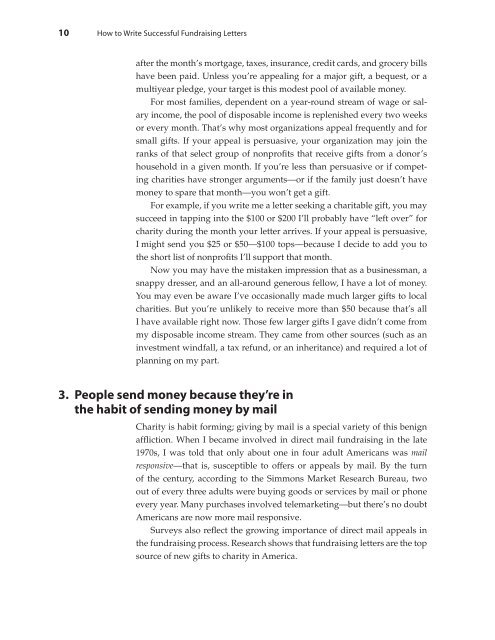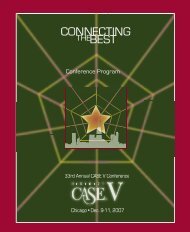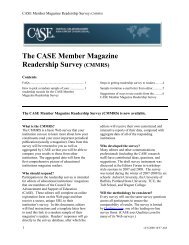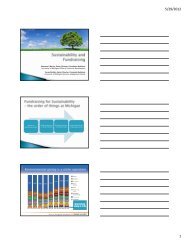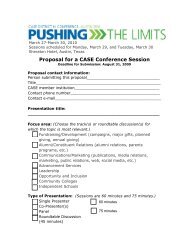Chapter 1 Why People Respond to Fundraising Letters - CASE
Chapter 1 Why People Respond to Fundraising Letters - CASE
Chapter 1 Why People Respond to Fundraising Letters - CASE
Create successful ePaper yourself
Turn your PDF publications into a flip-book with our unique Google optimized e-Paper software.
10 How <strong>to</strong> Write Successful <strong>Fundraising</strong> <strong>Letters</strong>after the month ’ s mortgage, taxes, insurance, credit cards, and grocery billshave been paid. Unless you ’ re appealing for a major gift, a bequest, or amultiyear pledge, your target is this modest pool of available money.For most families, dependent on a year - round stream of wage or salaryincome, the pool of disposable income is replenished every two weeksor every month. That ’ s why most organizations appeal frequently and forsmall gifts. If your appeal is persuasive, your organization may join theranks of that select group of nonprofits that receive gifts from a donor ’ shousehold in a given month. If you ’ re less than persuasive or if competingcharities have stronger arguments — or if the family just doesn ’ t havemoney <strong>to</strong> spare that month — you won ’ t get a gift.For example, if you write me a letter seeking a charitable gift, you maysucceed in tapping in<strong>to</strong> the $ 100 or $ 200 I ’ ll probably have “ left over ” forcharity during the month your letter arrives. If your appeal is persuasive,I might send you $ 25 or $ 50 — $ 100 <strong>to</strong>ps — because I decide <strong>to</strong> add you <strong>to</strong>the short list of nonprofits I ’ ll support that month.Now you may have the mistaken impression that as a businessman, asnappy dresser, and an all - around generous fellow, I have a lot of money.You may even be aware I ’ ve occasionally made much larger gifts <strong>to</strong> localcharities. But you ’ re unlikely <strong>to</strong> receive more than $ 50 because that ’ s allI have available right now. Those few larger gifts I gave didn ’ t come frommy disposable income stream. They came from other sources (such as aninvestment windfall, a tax refund, or an inheritance) and required a lot ofplanning on my part.3. <strong>People</strong> send money because they ’ re inthe habit of sending money by mailCharity is habit forming; giving by mail is a special variety of this benignaffliction. When I became involved in direct mail fundraising in the late1970s, I was <strong>to</strong>ld that only about one in four adult Americans was mailresponsive — that is, susceptible <strong>to</strong> offers or appeals by mail. By the turnof the century, according <strong>to</strong> the Simmons Market Research Bureau, twoout of every three adults were buying goods or services by mail or phoneevery year. Many purchases involved telemarketing — but there ’ s no doubtAmericans are now more mail responsive.Surveys also reflect the growing importance of direct mail appeals inthe fundraising process. Research shows that fundraising letters are the <strong>to</strong>psource of new gifts <strong>to</strong> charity in America.


